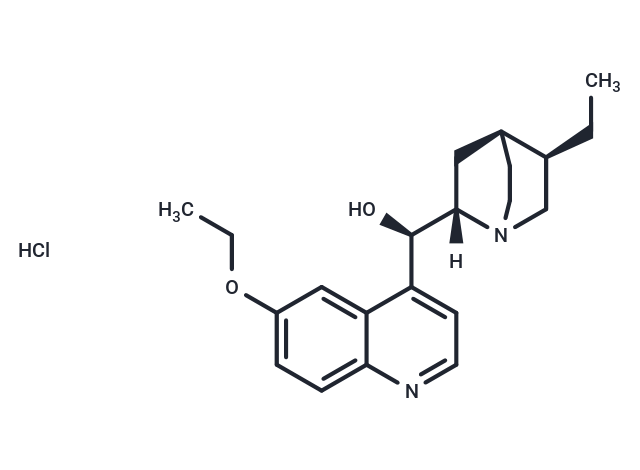Shopping Cart
Remove All Your shopping cart is currently empty
Your shopping cart is currently empty
Ethylhydrocupreine hydrochloride (Optochin hydrochloride) is a derivative of quinine with antimicrobial activity against Streptococcus pneumoniae and antimalarial activity with an IC50 of 25.75 nM against Plasmodium falciparum. It is also an agonist of Gallus gallus2 receptors (ggTas2r1, ggTas2r2, and ggTas2r7).

| Pack Size | Price | USA Warehouse | Global Warehouse | Quantity |
|---|---|---|---|---|
| 25 mg | $30 | In Stock | In Stock | |
| 50 mg | $48 | In Stock | In Stock | |
| 100 mg | $77 | In Stock | In Stock | |
| 200 mg | $112 | - | In Stock | |
| 1 mL x 10 mM (in DMSO) | $34 | In Stock | In Stock |
| Description | Ethylhydrocupreine hydrochloride (Optochin hydrochloride) is a derivative of quinine with antimicrobial activity against Streptococcus pneumoniae and antimalarial activity with an IC50 of 25.75 nM against Plasmodium falciparum. It is also an agonist of Gallus gallus2 receptors (ggTas2r1, ggTas2r2, and ggTas2r7). |
| Targets&IC50 | P. falciparum:25.75 nM (IC50) |
| In vitro | The mutation rate towards Ethylhydrocupreine (Optochin) resistance in three capsulated S. pneumoniae strains (S. pneumoniae D39 NCTC 7466, S. pneumoniae R6 ATCC BAA-255, and S. pneumoniae ATCC 49619) was determined through fluctuation analysis. It was found that for these strains, subinhibitory concentrations of penicillin noticeably increased the mutation rate (measured as mutations per cell division) to Ethylhydrocupreine (Optochin) resistance, with an enhancement ranging from 2.1- to 3.1-fold [2]. |
| In vivo | The highest tolerated dose of ethylhydrocupreine hydrochloride for guinea pigs by intrapleural injection is about 0.2 to 0.3 cc. of a 1:100 solution per 100 gm. of weight, corresponding to 2 to 3 cc. of solution or 0.02 to 0.03 gm. of the drug per kilo of weight. The injection of 1 cc. of a 24 hour dextrose blood broth culture of virulent Type I pneumococci into the right pleural cavity of guinea pigs produces acute suppurative pleuritis on both sides associated with suppurative pericarditis. The injection of 1 cc. of 1:500 solutions of Ethylhydrocupreine hydrochloride into each pleural cavity of guinea pigs at varying intervals up to 24 hours after pleural infection has usually shown a marked curative influence. Similar results are observed with dogs [1] . |
| Synonyms | Optochin hydrochloride |
| Molecular Weight | 376.92 |
| Formula | C21H29ClN2O2 |
| Cas No. | 3413-58-9 |
| Smiles | Cl.[H][C@]1(C[C@@H]2CCN1C[C@@H]2CC)[C@H](O)c1ccnc2ccc(OCC)cc12 |
| Relative Density. | no data available |
| Color | White |
| Appearance | Solid |
| Storage | Powder: -20°C for 3 years | In solvent: -80°C for 1 year | Shipping with blue ice/Shipping at ambient temperature. | |||||||||||||||||||||||||||||||||||
| Solubility Information | H2O: 50 mg/mL (132.65 mM), Sonication is recommended. DMSO: 125 mg/mL (331.64 mM), Sonication is recommended. | |||||||||||||||||||||||||||||||||||
| In Vivo Formulation | 10% DMSO+40% PEG300+5% Tween 80+45% Saline: 4 mg/mL (10.61 mM), Sonication is recommended. Please add the solvents sequentially, clarifying the solution as much as possible before adding the next one. Dissolve by heating and/or sonication if necessary. Working solution is recommended to be prepared and used immediately. The formulation provided above is for reference purposes only. In vivo formulations may vary and should be modified based on specific experimental conditions. | |||||||||||||||||||||||||||||||||||
Solution Preparation Table | ||||||||||||||||||||||||||||||||||||
H2O/DMSO
| ||||||||||||||||||||||||||||||||||||
| Size | Quantity | Unit Price | Amount | Operation |
|---|

Copyright © 2015-2025 TargetMol Chemicals Inc. All Rights Reserved.